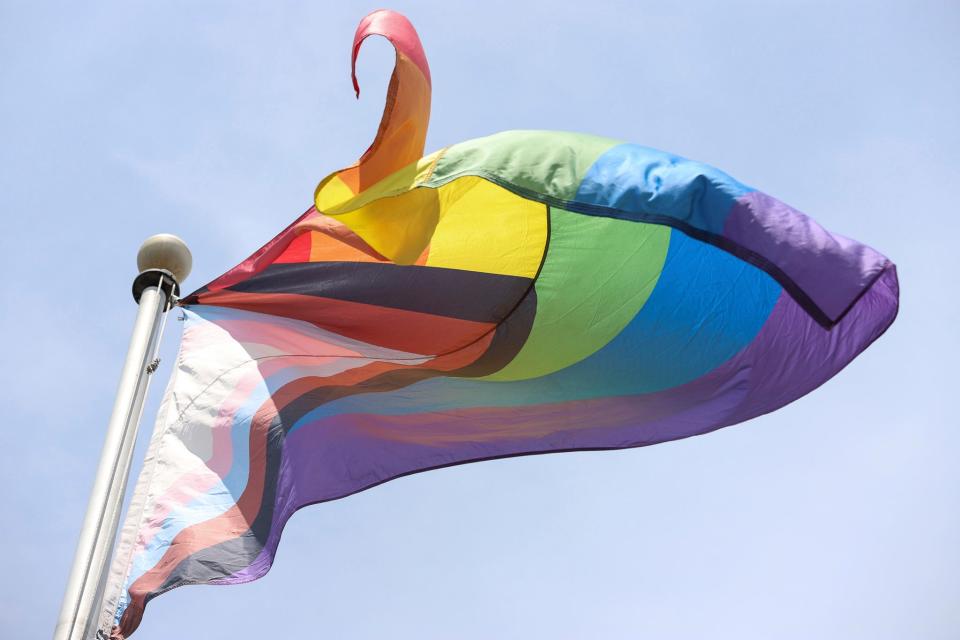Opinion: It isn’t about a rainbow flag. LGBTQ Michiganders are fighting for their lives.
Picture this: It’s the Fourth of July. I’m cruising west on sunlit I-696 from metro Detroit to Lansing to celebrate with family. The Beach Boys are playing over the car speakers, because I need the fun and weightlessness of their sound, and at 34, I’m a bit of an old soul. As I close in on the overpass at U.S. 23, I'm catching major vibes, and the rearview mirror offers a fleeting glimpse of the alerting orange blinkers and construction pylons of southeast Michigan.
I’m lost in my mind, driving a little below the acceptable speed limit for the left lane, so a truck in the right lane enters my peripheral vision. All I remember from the quick interaction is the American flag, craftily masted from the back-left window. It’s not aesthetically pleasing pinched up against the roof in the headwinds of the expressway, and my brain, despite being flooded by the bass notes of "I Get Around," still supplies that sound of a playing card flapping in the spokes of a bicycle.

The observation, however brief, jolts me away from the daydream of escaping to live in a VW bus with a surfboard and my record collection. Now, I see the star-spangled banner everywhere. She’s accompanied by the golden arches, towering and waving gently over my head as I pass exit ramps. She’s clinging tightly to the rear windows of cars in front of me. It has me reminiscing about my seventh-grade self, becoming accustomed to a new and indefinite post-9/11 ritual of first-hour science class being interrupted by a mono version of Lee Greenwood’s "God Bless the USA." I’m thinking about how the flag meant something different to me that fall than it had previously, when for a moment in time, it stood singularly for a nation’s collective grief and resilience.
I also recall how quickly the flag’s meaning became complicated. How in the ensuing months, Arab and Muslim Americans became targets for cheap political gains and wartime propaganda. How in the years to come, I would emerge from the boundaries of my hometown, and gain a deeper understanding of systemic injustices and how our nation’s history is very much a part of our present. As an adult, when I see the flag, I must juxtapose these things with the Springsteen-esque storyline of my American experience. I am, after all, the daughter of two parents who, without college degrees, kept food on the table for three kids, my dad giving 60,000+ hours of his life to the American foundry and my mom planting her roots at a local credit union, working her way from part-time teller to executive.
Discerning my own complex relationship with the American flag also makes it easier to recognize that relationship is equally, if not more, complex for every other American. It is a foundation to empathizing with Muhammad Ali's refusal to serve in Vietnam, Tommie Smith and John Carlos raising their fists, athletes taking a knee, protestors signaling distress by turning the Stars and Stripes upside down.

A revelation is sinking in. The flags we fly, and the flags we don’t, alone may mean something, but in the context of moments, they mean everything.
So when the Hamtramck City Council voted last month to ban flags representing the LGBTQ+ community and other American minority groups, predictable outrage followed. But what was seemingly missed in the both-sides coverage was some critical context.
More: What do the colors of the Rainbow Pride Flag mean? A history on how the flag came to be
More: Opinion: LGBTQ+ pride is being diluted by corporate rainbow washing
For starters, despite receiving an observably disproportionate share of the coverage, Hamtramck wasn’t the only municipality or school district considering restrictions of LGBTQ+ expression that week. Livingston County prevented their Human Services Collaborative Body and all other county-appointed entities from promoting pride events. Hartland Schools effectively banned the display of pride flags in district buildings.
I share this not to condone the council’s decision, but to begin to highlight the breadth of this issue, and frankly, to honor the intersecting intricacies of oppression, in that the negative portrayal of Muslims in the media is well documented. That phenomenon has held true in the coverage of anti-LGBTQ+ policies in Hamtramck and Dearborn, both with sizable percentages of Muslim and Arab American community members and elected office-holders.
However, the decisions by all of these bodies, despite the candy-coating in expressions of fairness and harm prevention (however legally flawed), cannot be decoupled from the legislative and cultural war being waged against the LGBTQ+ community.
More: Defying new law, LGBTQ+ pride flag is raised in Hamtramck, then removed by city
More: Is Livingston County following the roadmap Ottawa Impact created?
Over the course of years, a number of prominent groups opposing LGBTQ+ and specifically transgender rights have been building a political narrative. It started with conservative populist policies like sports bans, and has spiraled into a much broader assault on human rights, including bans on accredited healthcare, criminalization of parents and the erosion of free speech.
In the first six months of 2023, the Human Rights Campaign has tracked 560 anti-LGBTQ bills across state legislatures in the U.S., of which a record-setting 229 directly target transgender Americans. And according to Republican strategist Sarah Longwell, “They [the bills] are PR campaigns masquerading as legislation, designed to keep culture wars at the center of the conversation.”
More: Moms for Liberty, with foothold in Livingston County, named 'extremist group'
More: Opinion: I’m a Michigan-born LGBTQ teen living in NYC. I don’t want to come back.
While Hamtramck, Hartland and Livingston County make it evident that these policies and the messaging around them have infiltrated Michigan’s communities, urban and rural alike, we need to remember that it’s not the division they sow, but rather the real harm they cause that should remain in focus. Gender affirming care for youth has been associated with significantly lower odds of moderate or severe depression, or even suicide risk. In contrast, hearing about potential state or local laws banning discussions on LGBTQ people at school made nearly 2-in-3 LGBTQ young people’s mental health a lot worse. It’s also inspiring violence.
We know and accept that however beautiful we find it to be, the American flag’s aesthetics are not what bring it to life, move us to tears, or make us ponder our collective existence. It is instead, with the flag acting as the symbol, the context of our moments that bring us in touch with our deepest-seated emotions, values and virtues, and that context should not be overlooked in any critique or defense of this issue.
Once we analyze a flag ban at a school or government building, along with the rhetoric and policies happening across the country, it becomes harder for these bans to appear neutral. While the heat of the present provides ill-intent with the luxury of camouflage, history, as witnessed by the contextualization of Joe McCarthy or Samuel Parris, is rarely as forgiving to its oppressors.
LGBTQ+ Michiganders and their allies are not outraged over a rainbow flag; they are fighting for their lives.
Emme Zanotti is the director of advocacy and civic engagement at the Equality Michigan Action Network. Contact the Free Press opinion page: freep.com/letters.
This article originally appeared on Detroit Free Press: Opinion: Rainbow Pride flag fight is about LGBTQ Michiganders' lives

